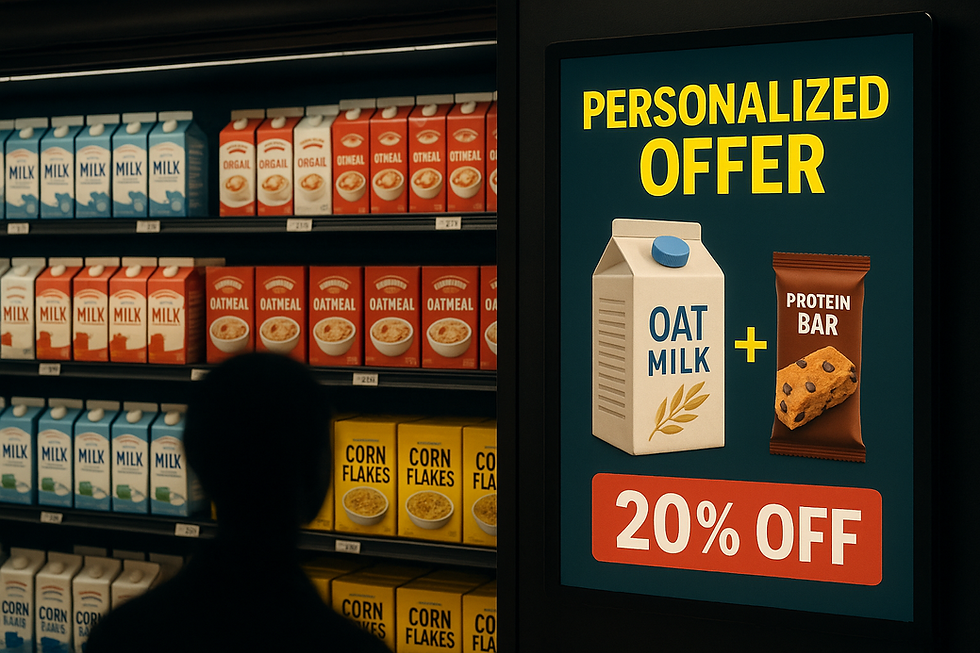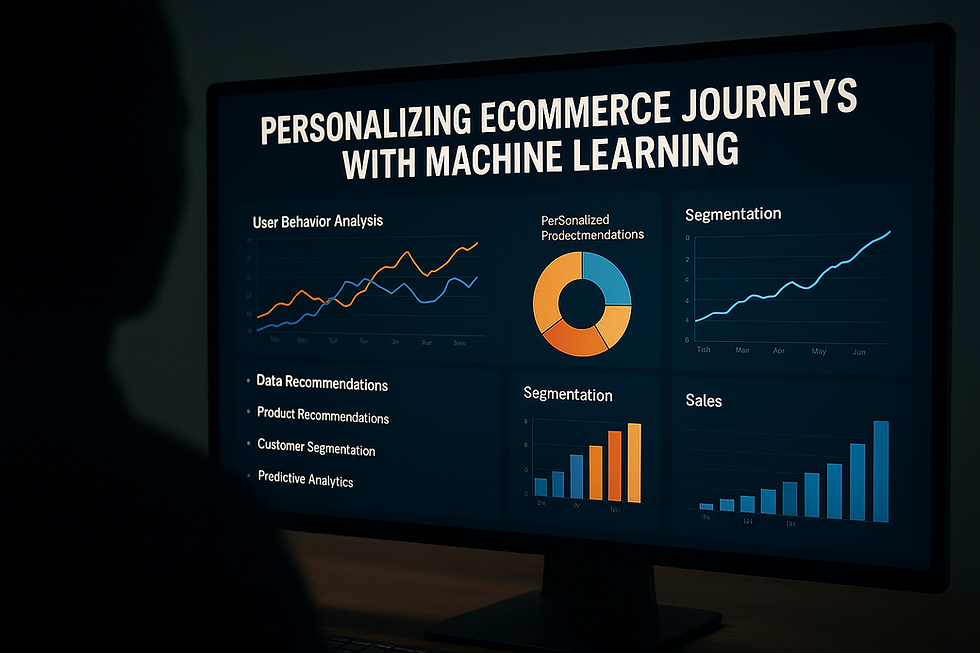AI in Email Personalization for Higher Sales Conversions
- Muiz As-Siddeeqi

- Aug 19
- 5 min read

AI in Email Personalization for Higher Sales Conversions
If you're still blasting generic email templates in 2025, you're not just behind — you're invisible.
Because while you're hoping your “Hi {FirstName}!” trick works, your competitor’s AI engine has already predicted exactly what time your prospect checks email, what offer they’ll click, and what subject line will trigger a purchase.
This isn’t the future. This is happening right now. And it’s backed by hard numbers, not hype.
AI email personalization for sales conversions isn’t just a marketing buzzword anymore — it’s a data-proven, revenue-generating machine. The businesses leveraging it aren't just improving click rates; they’re rewriting what’s possible in email-driven revenue.
In this blog, we’re diving deep — and we mean deep — into the documented, data-driven, real-world transformation that AI-driven email personalization is bringing to sales conversions across industries.
We’re not talking theories or vague “best practices.” We're unpacking proven use cases, breakthrough research, and jaw-dropping success stories (yes, all real, all documented) that are changing how businesses communicate, convert, and scale.
So buckle up. Because this post isn’t just informative. It’s war paint for your next email campaign.
Bonus: Machine Learning in Sales: The Ultimate Guide to Transforming Revenue with Real-Time Intelligence
What Happens When You Still Use Generic Email Campaigns?
Here’s the raw, painful truth:
According to HubSpot’s 2024 State of Marketing Report, average email open rates are now under 17% globally. Click-through rates? A dismal 1.7%. And conversion rates? Not even 0.5% in many industries.
Now compare that with AI-personalized campaigns.
In a 2023 Adobe Digital Trends report, companies using machine learning personalization in email campaigns reported a 2.4x higher click-through rate and 3.5x higher revenue per email.
This isn’t a minor lift. It’s an overhaul of performance.
And the reason is simple:Relevance = Revenue.Repetition = Ruin.
The Cold Hard Numbers Behind AI-Powered Email Personalization
Let’s break down the real, documented, mind-blowing stats:
Statista (2024) found that companies using AI for personalized emails reported a 41% increase in email revenue year-over-year compared to those that didn’t.
McKinsey & Company reported in a 2023 study that personalization at scale (especially using AI tools) can boost sales by 10–20% and marketing spend efficiency by up to 30%.
Salesforce’s State of Marketing (2024) confirmed that 76% of marketers who used AI tools saw improved engagement, and 58% saw higher customer lifetime value.
Segment’s Personalization Maturity Report showed that real-time personalization (driven by AI) can lift conversions by over 202% compared to static, one-size-fits-all campaigns.
These aren't future predictions. These are last year’s results.
How Does AI Actually Personalize an Email?
This isn’t about slapping the customer’s name on the subject line.
Here’s what real AI personalization looks like:
Predictive Send Times: AI predicts the exact time each user is likely to open and engage with emails based on their behavior history.
Dynamic Content Blocks: Different users get entirely different offers, images, CTAs, and even layouts — all in real time.
Micro-Segmentation: AI can create hundreds (yes, hundreds) of segments based on behavior, not just demographics.
Tone Adaptation: Tools like Phrasee, which use natural language generation (NLG), can change the tone and style of your emails to match user profiles.
Product Recommendation Engines: AI suggests products or services based on a user’s browsing, purchase, and even competitor interaction data.
This level of customization is impossible to scale manually. But for AI, it’s just another Tuesday.
Real Companies. Real Results. Real Case Studies.
1. eBay:
eBay deployed an AI personalization engine to generate over 100 million email versions per campaign. Each email was personalized based on user behavior, previous purchases, and predictive interest scoring.
Result: 3x increase in CTR and a 2x increase in revenue per email.
Source: Salesforce + eBay Email Innovation Case Study (2023)
2. Netflix:
Using machine learning to personalize recommendation emails, Netflix was able to boost content click rates by more than 60%. Their AI engine predicts what a user wants to watch next — and sends the right teaser at the right time.
Source: Netflix Personalization Research (2023)
3. Sephora:
Sephora integrated AI-powered tools like Dynamic Yield for personalized email content blocks. Customers receive recommendations tailored to their skin tone, past purchases, and even beauty quiz results.
Result: 2.5x increase in conversion rate from email.
Source: Dynamic Yield Case Studies (2023)
4. Dell:
Dell used AI for hyper-personalized B2B email sequences targeting enterprise clients. Emails adapted dynamically to buyer stage, industry, and intent data.
Result: $40M+ in pipeline impact within 6 months.
Source: Adobe Summit Dell Case Study (2023)
This is what documented ROI looks like when you stop guessing and start personalizing.
Breaking Down the Tech: What Tools Are Leading the AI Email Game?
Here are battle-tested platforms businesses are using right now (all real):
Persado: AI-generated emotional language in subject lines and CTAs. Used by AmEx and Vodafone.
Seventh Sense: Predictive send-time optimization based on individual behavior (especially strong for HubSpot users).
Dynamic Yield: Full-funnel personalization across email, web, and app. Used by Sephora and Lacoste.
Phrasee: NLP-based tool to optimize email subject lines, preheaders, and body text. Brands like Domino’s and Virgin Atlantic swear by it.
Drift Email: Automated AI follow-ups and routing for B2B sales email personalization.
Salesforce Einstein: Embedded into Salesforce CRM and Marketing Cloud, it offers predictive lead scoring and personalized engagement paths.
Each tool is well-documented and comes with full enterprise-grade AI under the hood — no gimmicks, no guesswork.
What Happens Inside the AI Brain Before You Hit “Send”?
Let’s peek into the AI email personalization workflow:
User Data Collection: Behavior tracking, CRM history, purchase patterns, site interactions, email clicks.
Segmentation Algorithm: ML models segment your audience by hundreds of micro-behaviors, not static rules.
Content Recommendation: NLP + deep learning models suggest subject lines, offers, product blocks, and even design formats.
Predictive Scoring: AI scores each email’s likelihood to convert — before you even send it.
Automated A/B Testing at Scale: AI runs dozens of A/B tests simultaneously and adapts in real time.
Send-Time Optimization: AI deploys messages exactly when your individual recipient is most likely to engage.
From Cold Outreach to Warm Closes: The Impact on Sales Teams
We’ve seen a huge shift in how sales reps operate. The age-old “spray and pray” model is dead.
With AI-personalized emails:
SDRs are seeing open rates over 50% (compared to the cold average of 16%).
Response rates have jumped by 300%+ in B2B mid-market campaigns (source: Outreach.io 2024 Sales Tech Report).
AI-personalized follow-ups in sales sequences have led to deal acceleration — shortening pipelines by 23% on average.
One example?
Gong.io, which integrated AI-personalized email cadences across its outbound team, saw a 27% higher meeting booked rate within 60 days.
Source: Gong Sales Enablement Playbook (2023)
Debunking the Myths (Backed by Data)
Let’s kill the nonsense:
“AI email feels robotic” → Actually, Persado’s emotional AI outperforms human-written copy in 92% of A/B tests (source: Persado 2023 Report).
“It’s too expensive” → Entry-level AI personalization tools start at under $50/month. ROI pays for itself within weeks.
“We don’t have enough data” → Tools like Mailchimp’s Customer Journey Builder can start working even with 100 subscribers using predictive logic.
“Our industry is too niche” → AI email personalization is industry-agnostic. If humans open your emails, AI can personalize them.
The Cost of Doing Nothing
This is not just about growth. It’s about survival.
Because while you’re deciding whether to invest, your competitors are already optimizing open times, content, tone, and CTA placements — and they’re eating your market share one email at a time.
And the worst part?
Your prospect probably doesn’t even remember your brand.
But they do remember the one that offered them the right solution, in the right tone, at the right moment.
Final Thoughts: Email Isn’t Dead — But Your Strategy Might Be
We’ve seen the numbers. We’ve read the case studies. We’ve tested the tools. And one thing is crystal clear:
AI isn’t replacing email. It’s rescuing it.
If you’re serious about conversions, brand trust, and customer relationships — AI personalization isn’t optional. It’s oxygen.
And the best time to start was yesterday. The second-best? Right now.

$50
Product Title
Product Details goes here with the simple product description and more information can be seen by clicking the see more button. Product Details goes here with the simple product description and more information can be seen by clicking the see more button

$50
Product Title
Product Details goes here with the simple product description and more information can be seen by clicking the see more button. Product Details goes here with the simple product description and more information can be seen by clicking the see more button.

$50
Product Title
Product Details goes here with the simple product description and more information can be seen by clicking the see more button. Product Details goes here with the simple product description and more information can be seen by clicking the see more button.






Comments